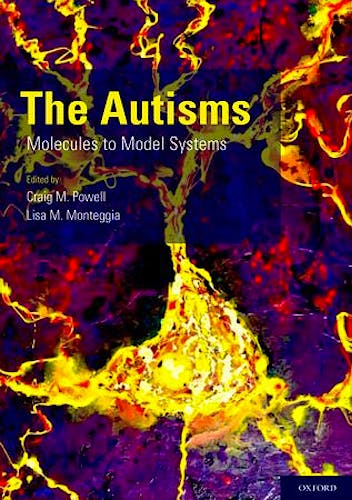

No hay productos en el carrito



The Autisms: Molecules to Model Systems
Powell, C. — Monteggia, L.
1ª Edición Noviembre 2012
Inglés
Tapa dura
416 pags
1206 gr
19 x 26 x 3 cm
ISBN 9780199744312
Editorial OXFORD
LIBRO IMPRESO
-5%
195,79 €186,00 €IVA incluido
188,26 €178,85 €IVA no incluido
Recíbelo en un plazo de
2 - 3 semanas
About the book
- Covers the science of autism from clinical genetics to animal models
- Beautifully illustrated with 4-color images throughout
The science of autism has seen tremendous breakthroughs in the past few decades. A multitude of relatively rare mutations have been identified to explain around 15 % of autism cases with many of these genetic causes systematically examined in animal models. This marriage of human genetics and basic neurobiology has led to major advances in our understanding of how these genetic mutations alter brain function and help to better understand the human disease.
These scientific approaches are leading to the identification of potential therapeutic targets for autism that can be tested in the very same genetic models and hopefully translated into novel, rational therapies. The Autisms: Molecules to Model Systems provides a roadmap to many of these genetic causes of autism and clarifies what is known at the molecular, cellular, and circuit levels. Focusing on tractable genetic findings in human autism and painstakingly dissecting the underlying neurobiology, the book explains, is the key to understanding the pathophysiology of autism and ultimately to identifying novel treatments.
Readership: Neuroscientists, Clinicians, Psychologists, Graduate Students, and Advanced Undergraduates
Table of contents
1. Introduction
Craig M. Powell & Lisa M. Monteggia
2. Autism and Autism Spectrum Disorders: Clinical Overview
Lisa Joseph, Sarah Spence & Audrey
3. Neuroimaging in Autism Spectrum Disorders Human Imaging
Mikle South, John D. Herrington, Sarah J. Patterson
4. An overview of the genetics of autism spectrum disorders
Joseph D. Buxbaum
5. Rett syndrome: On Clinical and Genetic Features, and Experimental Models
based on Mecp2 dysfunction
Gaston Calfa, Alan K. Percy and Lucas Pozzo-Miller
6. Mecp2 Knockout in mouse models of Rett syndrome
Megumi Adachi and Lisa M. Monteggia
7. Putting into perspective the use of the Fmr1 KO mouse as a model for autism
spectrum disorder
Richard Paylor
8. Molecular functions of the mammalian fragile X mental retardation protein:
Insights into mental retardation and synaptic plasticity
Claudia Bagni & Eric Klann
9. Tuberous Sclerosis and Autism
Dan Ehninger and Alcino J. Silva
10. PTEN and autism with macrocephaly
Craig M. Powell
11. SHANK gene family and autism
Craig M. Powell
12. Smith-Lemli-Opitz Syndrome and Role of Cholesterol in Autism
Geeta Sarphare, Ryan Lee, and Elaine Tierney
13. Angelman Syndrome
Edwin J. Weeber
14. Neuroligins and neurexins: Bridging the synaptic cleft in autism
Craig M. Powell & Antony A. Boucard
15. Alterations of the serotonin-melatonin pathway in autism spectrum disorders:
Biological evidence and clinical consequences
Cecile Pagan, Richard Delorme, Jean-Marie Launay, Thomas Bourgeron
16. CNTNAP2 and autism spectrum disorders
Olga Penagarikano & Daniel H. Geschwind
17. Chromosome 15q11.2q13.3 Aneusomies and Autism Spectrum Disorders
David J. Wu and Carolyn Schanen
18. Oxytocin and vasopressin: Mechanisms for potential sex differences observed
in ASD
C. Sue Carter & Suma Jacob
19. FOXP2: Linking language and autism
Genevieve Konopka
© 2025 Axón Librería S.L.
2.149.0